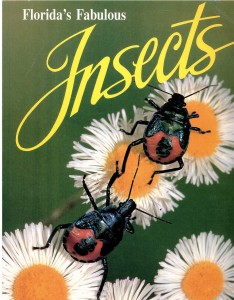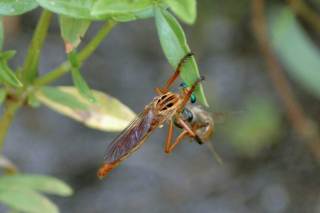I was browsing my favorite used bookstore in Boca the other day (I say “my favorite,” but actually, I think it’s the only used bookstore in Boca. Nevertheless.) when I ran across four volumes in the Florida’s Fabulous… series. I pounced on them the way a tiger beetle pounces on other beetles, or a robber fly pounces on a bee, even though paying full price for these large format mass market volumes wouldn’t break the bank.
Mark Deyrup, the author of Florida’s Fabulous Insects, is another of those entomological writers who proves how one can relate charming stories in an engaging way. (Thomas Eisner and E.O. Wilson being the modern flagbearers of this writing style that goes back at least as far as Darwin, the beetle-lover. May Berenbaum comes to mind as well.) I was going to quote you some, but then I discovered that I would pretty much have to just blog the entire book, which isn’t cool.
So I won’t be able to show you quotes like this one:
So varied are the Hymenoptera, that there are no simple features that label its members at a glance, except perhaps the possession of two pairs of transparent wings, the forewings much larger than the hind wings. This is one of those classroom distinctions that is wonderfully obvious in diagrams, but not at all obvious out in the garden. (138)
Or this one:
Studies of Florida Hymenoptera are still in a pioneering stage, and even guesses about the number of species in the state have a wild and wooly quality: probably more than 3,000; probably less than 6,000. More than 1,000 species have been found on the Archbold Biological Station in south-central Florida, so there can be masses of species even at a single site. All specialists working on groups of Hymenoptera find species unknown to scientists when they begin working in Florida. (138–9)
Or this one:
Florida has many more species of horse and deer flies than most people realize, largely because one squashed fly looks rather like another. There are about 100 species in Florida. (124)
Well, my unofficial quote limit is three, so that’s all you get. If you want more, go to any bookstore in Florida and you can find a new copy; I was just excited because I found this one at a discount in a used store. And I think I met the author several years ago when I visited Archbold in the company of an astronomer friend of mine who works there… So, yay me! (Where can you say yay me, if not your own blog?)

References
Deyrup, Mark. (2000). Florida’s Fabulous Insects. Tampa, FL: World Publications.
UPDATE: After joining Odonata Central, I discovered that back issues of their newsletter, Argia, are open to the public. So I thought I’d add this review of the book by none other than Sidney Dunkle. It appears in Argia: The News Journal of the Dragonfly Society of the Americas, 12:2, 20 July 2000, pp. 16-17:
FLORIDA’S FABULOUS INSECTS, by Mark Deyrup
Book review by Sid Dunkle, Plano, TX.
This, one of the most beautiful insect books I have seen, is a large-format, soft-cover book, filled cover to cover with color photos. The principal author is Mark Deyrup, a very knowledgeable entomologist, from whom I learned interesting snippets of information throughout the 169 pages of the book. The Odonata are covered on pages 6 to 25, including 54 color photos oftarvae and adults. The book, published in 2000, has already had 3 printings, and courtesy of editor Tim Ohr, I was able to correct nearly all of the (few) errors that were present in the odonate chapter of the second printing. Some of the odonate photos were posed, some were not. A few of the posed photos are misleading, namely: 1) Three dragonflies are shown perched on flowers, which they rarely do, 2) One female Erythemis simplicicollis is shown eating another as they face each other, and 3) Tramea onusta is shown eating a honeybee, although I have no records of such large prey for this species. My only other objection is that scientific names of species are not given, although the reader will be able to identify nearly all the photos of adult odonates by referencing my Florida field guides.
[Updated to correct a couple of typos. Sorry!]

